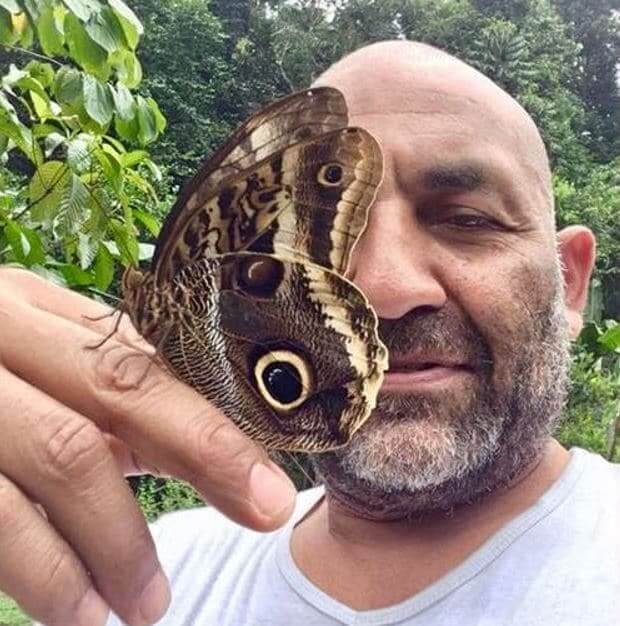Oswaldo Maciá

Oswaldo Maciá was born in the Caribbean city of Cartagena de Indias, Colombia. He lives and works in the UK and USA.
In 1976 he attended the School of Fine Arts in Cartagena at the age of 16, graduating in 1980. In 1982 he moved to the capital Bogotá to study advertising at Jorge Tadeo Lozano University, and left after five semesters to become a full-time artist. Maciá taught Fine Art at Jorge Tadeo Lozano University from 1985 before moving to Barcelona in 1989, where he studied Mural Painting at Llotja School of Fine Art.In 1990 Maciá moved to London, where he continues to run a studio. He studied BA in Sculpture between 1990 and 1993 at Guildhall University followed in 1994 by Masters in Fine Art at Goldsmiths College, University of London. In the 1990s his work featured in solo exhibitions in London venues at the forefront of defining installation art, including the Museum of Installation and Clove Gallery, and group exhibitions such as Ideal Standard Summertime at Lisson Gallery.
Maciá creates olfactory-acoustic sculptures that have been exhibited all over the world. His work is held in international collections, including Tate Britain and Daros Latinamerica. His sculptures have been included in numerous large-scale periodic exhibitions and solo presentations across four continents. As he states in his manifesto, Maciá seeks to stimulate questions and counter received opinion. In 2015 Maciá won a major public commission for the city of Bogotá selected by an international jury. Scenario in Construction is the first public sound sculpture of in the southern hemisphere.
The sense of smell features in many of Maciá’s sculptures. In 2018 he was commissioned by the first Riga Biennial to create An Opera of Cross-pollination, a room-sized olfactory-acoustic sculpture that positions the audience at the frontier where knowledge ends and ignorance begins. According to Maciá, this is the place where the senses begin to speak. In a yellow room, volumes of insect sounds gathered from the rainforest in Choco, Colombia combine with the sounds of metal fences and the scent of cross-pollination. In 2018 Maciá won the Golden Pear at the fifth annual Art and Olfaction Awards in London for his experimental work with scent. He was awarded the Prize for the presentation of Under the Horizon (2011/17) at Sala San Antonio Abad – Centro Atlántico de Arte Moderno Gran Canarias España. The smell composition of Under the Horizon draws from the scent of organisms growing under the earth, while employing sculptural conventions and narrative expectations. A plinth elevates a bath to eye level where the taps are constantly running unchecked, filling the tub with a black liquid holding the scent of ‘under’, accompanied by the sounds of cloth being stitched by machines, mixed with the sound of artificial rain. These recordings were made by the artist in a large Bulgarian factory, manufacturing military uniforms for different wars on our planet.
Ten Notes for a Human Symphony was first presented at the Thessaloniki Biennale, Greece (2009), which consists of ten canvas curtains slowing moving, each impregnated with a unique scent. The artist gathered a lock of human hair that had never been chemically treated from men and women living in Argentina, India, Ireland, Japan, Kenya, Mexico, Peru, Russia, Syria and Tibet. Each was analysed in a Paris perfume laboratory using the technique known as ‘headspace’. The result was analysed and interpreted by a master perfumer who created a new smell, or ‘note’, for each sample. In 2000 Maciá was commissioned to make one of the first olfactory sculptures presented in a museum for Continental Shift, A Voyage Between Cultures at Ludwig Forum International Kunst in Aachen, Germany. Algae Garden comprises 150 fragrances of rare flower species, fruits and vegetables from all over the world. The installation consists of five rings that rotate once a minute; hanging from each are thirty tampons holding one of the fragrances.
Sound too is important in his work. Something Going on Above My Head (1995-99), an installation comprising sixteen speakers playing a symphony of two thousand birdcalls from Africa, the Americas, Asia and Europe, has been exhibited in nine countries – most recently at Tate Britain (2016) in London. Surrounded in Tears (2004) has been exhibited in many museums, including Tate Liverpool (2004) and the Bienal de Cuenca, Ecuador (2011) where Maciá was awarded the first prize. Comprising twenty-two megaphones, each dedicated to a different sound channel, this sculpture is a symphony of one hundred human crying sounds sampled from different cultures and periods. Researching the sounds of tears for two years, the artist consulted recordings and references from a number of collections including ethnographic sound archives across Europe, the Freud Museum in London, the archives of the radio channel Caracol in Colombia, and he gathered the sounds of new born babies from the Royal London Hospital in Whitechapel, London. At Manifesta 9 in Belgium (2012) Maciá presented Martinete (2011-2012), an olfactory-acoustic sculpture he began researching for the 2011 Porto Alegre Biennial in Brazil.
Collaboration is an important part of Maciá’s artistic practice, and he has a long-standing collaboration with Ricardo Moya, Senior Perfumer of International Flavors & Fragrances. Trilogy for Three Timbres, commissioned in 2016 by Museo Universitario Arte Contemporáneo Mexico, was created through a collaboration with Dr Fernando Montealegrez of University of Lincoln and the composer Edmar Soria. In 2010 Maciá worked on the opera INXILIO el sendero de las lágrimas with choreographer Alvaro Restrepo of El Colegio del Cuerpo, where he created the sound component. The installation for Maciá’s Surrounded in Tears, commissioned by the Liverpool Biennial, was made in collaboration with the composer Michael Nyman and the designer Jasper Morrison. Maciá’s eight-channel sound sculpture E2 7SD, created with Santiago Posada of StudioAural was presented in a collaboration with choreographer Rafael Bonachela and won the inaugural Place Prize in 2004. Maciá worked with the filmmaker Patrick Jolley on a number of moving image installations, including Soufflé (2008), a twelve-screen installation based on recordings of abattoirs, and Equilibrium (2010), a work that starts with field recordings of completely white bats.
